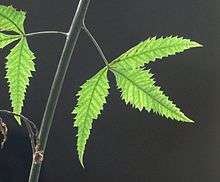Smodingium
| African poison ivy | |
|---|---|
 | |
| A sprig in the Pretoria N.B.G. | |
 | |
| Compound leaf | |
| Scientific classification | |
| Kingdom: | Plantae |
| Clade: | Angiosperms |
| Clade: | Eudicots |
| Clade: | Rosids |
| Order: | Sapindales |
| Family: | Anacardiaceae |
| Subfamily: | Anacardioideae |
| Genus: | Smodingium E.Mey. ex Sond. in Harv. & Sonder |
| Species: | S. argutum |
| Binomial name | |
| Smodingium argutum | |
Smodingium argutum, the African poison ivy, is a southern African shrub or medium-sized tree in the Anacardiaceae, which has properties comparable to the American poison ivy,[1] as its sap contains heptadecyl catechols that are toxic to the skin.[2]
It is commonly known as the pain bush.[3]
An immuno-chemical reaction is suspected as in other toxic anacardiaceous species.[1] It is monotypic in the genus Smodingium,[1] and was discovered in Pondoland by J. F. Drège during an 1832 expedition with the zoologist Andrew Smith.[1]
Description
It resembles Rhus species in habit and foliage. It is very variable in size, sometimes a woody shrub barely 1–2 feet high, or otherwise a tree of up to 6m. During summer it produces small, creamy green flowers arranged in large sprays.[2] The Greek generic name, meaning "durated mark",[1] alludes to its hard, flattened seeds, which are fitted with papery wings.[2] The margins of the alternately arranged, trifoliolate leaves are toothed, as suggested by its specific name, argutum, which means "sharp".[1] The foliage assumes attractive autumn colours. When damaged the twigs exude a creamy, poisonous sap, which turns black when the catechols contained in it polymerize to a melanin.[1]
Range
It occurs along the Mpumalanga escarpment, the uplands of Swaziland, the KwaZulu-Natal midlands, Pondoland and Transkei, southern Lesotho and the southern Free State.[2]
References
- 1 2 3 4 5 6 7 Findlay, G.H. (31 August 1963). "Dermatitis of 'Poison Ivy' type from an indigenous South African plant - Smodingium argutum". S.A. Tydskrif vir Geneeskunde: 883–888.
- 1 2 3 4 Botha, C.J., Venter, E. "Smodingium argutum". (Paraclinical Sciences - Pharmacology & Toxicology). University of Pretoria. Retrieved 21 March 2013.
- ↑ Melissa Petruzzelloa. "7 Dangerous Plants You Should Never Touch". ENCYCLOPÆDIA BRITANNICA.